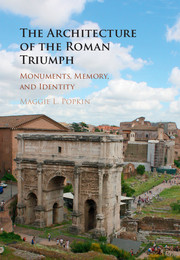Book contents
- Frontmatter
- Dedication
- Contents
- List of Figures
- List of Tables and Color Plates
- Acknowledgments
- INTRODUCTION: THE TRIUMPH, MEMORY, AND “BEING ROMAN” IN THE CITY OF ROME
- 1 THE TRIUMPHAL ROUTE
- 2 BUILDING MEMORIES: THE ERA OF THE PUNIC WARS (264–146 B.C.)
- 3 SPECTACLE AND MEMORY: THE REIGN OF TRAJAN, OPTIMUS PRINCEPS (A.D. 98–117)
- 4 MONUMENTS AND MEMORY DISTORTION: THE REIGN OF SEPTIMIUS SEVERUS (A.D. 193–211)
- CONCLUSION
- Appendix Victory Monuments Built along the Triumphal Route during the Punic Wars: Topography, Dating, and History
- Notes
- References
- Index
- COLOR PLATES
4 - MONUMENTS AND MEMORY DISTORTION: THE REIGN OF SEPTIMIUS SEVERUS (A.D. 193–211)
Published online by Cambridge University Press: 05 July 2016
- Frontmatter
- Dedication
- Contents
- List of Figures
- List of Tables and Color Plates
- Acknowledgments
- INTRODUCTION: THE TRIUMPH, MEMORY, AND “BEING ROMAN” IN THE CITY OF ROME
- 1 THE TRIUMPHAL ROUTE
- 2 BUILDING MEMORIES: THE ERA OF THE PUNIC WARS (264–146 B.C.)
- 3 SPECTACLE AND MEMORY: THE REIGN OF TRAJAN, OPTIMUS PRINCEPS (A.D. 98–117)
- 4 MONUMENTS AND MEMORY DISTORTION: THE REIGN OF SEPTIMIUS SEVERUS (A.D. 193–211)
- CONCLUSION
- Appendix Victory Monuments Built along the Triumphal Route during the Punic Wars: Topography, Dating, and History
- Notes
- References
- Index
- COLOR PLATES
Summary
INTRODUCTION
L. Septimius Severus came to power in A.D. 193 after a protracted and brutal civil war and ruled until A.D. 211. Under Septimius, Rome experienced a resurgence of monumental building that encompassed the whole city but that had a particularly transformative effect on the triumphal route. Of all the emperors following Trajan, Septimius undertook the greatest number of new constructions and significant renovations along the triumphal route until Maxentius and Constantine. In the Forum Romanum, his eponymous arch and equestrian statue presented him as a superlative military leader, while he transformed the eastern side of the Palatine Hill with an extension of the imperial palace and the construction of a monumental nymphaeum called the Septizodium and a massive temple–terrace complex on the Vigna Barberini.
Themes of victory and triumph resonated throughout Septimius's art and architecture, much as they had in Trajanic monuments. From buildings in the city of Rome such as those just mentioned to distant monuments such as the arch in Leptis Magna bearing scenes of a triumphal procession (Figure 4.1), Septimius evidently cared about the idea of triumph. Unlike Trajan, however, Septimius did not rule over a Roman Empire at its apex of wealth, geographic dominion, and security. His reign provides an opportunity to compare monuments built along the triumphal route and Romans’ conceptions of triumphs in a period of remarkable stability and prosperity with those from a period of greater volatility and stress. This chapter examines how sound Septimius's Parthian victories really were and whether he actually celebrated a triumph for them. It argues that Septimius built such impressive monuments at prominent locations on the triumphal route to manipulate how people remembered his tenuous victories – to amplify memories of a triumph, if he celebrated one, or even to construct false memories of a triumph, if he did not celebrate one. We cannot definitively answer the question of whether Septimius triumphed, but we can trace the impact his monuments have had on how ancient and modern historians recall his achievements. In the face of a literary record that does not preserve mentions of a Severan triumph and a material record that insists on Septimius's military accomplishments, the monuments have often won out in shaping the historiographical record.
Information
- Type
- Chapter
- Information
- The Architecture of the Roman TriumphMonuments, Memory, and Identity, pp. 135 - 181Publisher: Cambridge University PressPrint publication year: 2016
